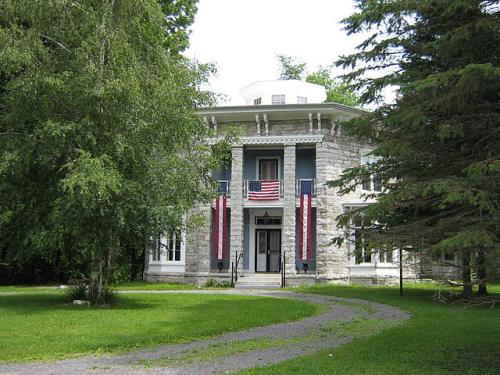Notes
- <IMG SRC="yw915.jpg" align=left> Biography of Linus Yale Sr. LinusYale, first of Middletown, Conn., and later of Newport, HerkimerCounty, N. Y., married Chiotilda Hopson, September 27, 1815. She wasborn May 6, 1797. To Linus Yale Sr., belongs the honor of being theoriginal inventor of locks to which the name "Yale" was given. Hisson, Linus Yale Jr., was the actual inventor in later years of the pintumbler, flat keyed lock, which brought to the name the universal andworld-wide celebrity and made the name Yale synonymous with excellenceand high standard in the lock world; but the father was the pioneer inthe Yale lock field; he hewed the way, opened the road and led theadvance, that eventually reached to great fame for his family name. Hewas born April 27, 1797, in Middletown, Conn. His parents moved toSalisbury, Herkimer Co., N. Y., where be resided with them on a farmfor a time. About 1835 he removed to Newport, N. Y., and in 1837 hewas granted a patent on threshing machines. This patent was signed byPresident Andrew Jackson. Previously, in 1829-1830 he had invented aprocess for dressing mill stones, by which an unskilled workman couldsharpen the grinding surface as well as a skilled mechanic. Later onhe invented the "Yale sawmill head block dog," which mechanicallyadjusted the log with rapidity and exactness and has never beensurpassed; no sawmill was thought to be well equipped without it Hedisposed of this patent and used the money received for same to buildand equip a factory for the manufacture of locks, which were his chiefinventions. He also made numerous inventions besides those mentionedand almost always sold them, to provide funds for the up building ofthe lock business. About 1840-1845 he commenced the manufacture of theYale bank lock, which with its improvements became famous wherevertreasures were protected by safes or vaults. About 1847 he brought outthe "Yale Magic Bank Lock," and in that year he purchased the land andwater rights where the ruins of the "old Yale lock factory now standin Newport, and built the stone building which is shown in the platein this book. He obtained power for his factory from a small stream,by building two dams, which stored sufficient water to operate theworks. A very successful business was conducted at these works formany years. During this later period Mr. Yale associated with himselfin the lock business. Mr. Ira L. Cady, who married his daughterChlotilda Yale, and for whom he built a home in the upper part of thevillage, known as "The Cady Place;" the house being of octagonal formand built of stone. It still stands near the old lock factory and isone of the beauties of Newport's architecture. Mr. Ira L. Cady becameprominent as an expert in all work in connection with the constructionof safes and vaults, using in his work the Yale locks. Mr. Cady forbusiness reasons, mainly to secure the metropolis in distribution,removed later to New York City, where he continued in the sale of banklocks and safe work. Mr. Yale's son Linus, Jr. joined him in the lockbusiness, in 1849, and later became, as set forth in his biography inthis volume, the greatest of all men in the art of lock making. Theson finally engaged in the lock business on his own account, and aboutthe year 1855 removed his business to Philadelphia. Linus Yale Sr.,was a sound thinker and of eminently independent judgement, and hisopinions on all public questions affecting the community, were greatlyrespected; and his excellent judgement was especially manifested inconnection with the proposed building of the railroad from Herkimer toClayton, when his practical judgement was proof the enthusiasm of thehour, and the then impractical project was against abandoned; thussaving the community from a great burden, which later events provedwould have been almost disastrous. He was one of the two directors inthis proposed company, appointed from Herkimer county. Mr. Linus Yale,Sr., died in 1857, and the business at Newport,, was carried on byMessrs. Tyler and Harris, as his successors. In 1861 the plant andbusiness was purchased by Harris brothers, who successfully conductedthe business for many years, after which they disposed of same to aparty in Albany, who pursued in the same lines for a time. Recentlyhowever, the entire plant, good will, name and etc., have beenpurchased by parties in the central part of the state and relocatednearer the old home. During all these changes in ownership, thebusiness never lost its connection with the name "Yale" and perhapsnever will. It might be well to state again here, however. that thegreatest prominence given to the name of Yale, in connection withlocks, was brought out by the branch of the business founded by theson, Linus Yale, Jr., as set forth in his biography herein. -From "TheYales and Wales" by Rodney Horace Yale, 1908. <br clear=all>
Page created using GEDmill 1.11.0



